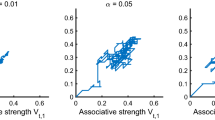Abstract
Joint or shared attention is a fundamental cognitive ability, which manifests itself in shared-attention episodes where two individuals attend to the same object in the environment. Network-oriented modeling provides an explicit framework for laying out this attentional process from the perspective of the individual initiating the episode. To this end, we describe an adaptive network with two reification levels and clearly explain the role of its states. We conclude with some suggestions for extending this modeling work and thinking about the potential use-cases of more developed models.
Access this chapter
Tax calculation will be finalised at checkout
Purchases are for personal use only
Similar content being viewed by others
References
Akhtar, N., Gernsbacher, M.A.: Joint attention and vocabulary development: a critical look. Lang. Linguist, Compass 1(3), 195–207 (2007)
Goldman, A.I.: Simulating Minds: The Philosophy, Psychology, and Neuroscience of Mindreading. Oxford University Press, Oxford (2006)
Hebb, D.O.: The Organization of Behavior: A Neuropsychological Theory. Wiley, Hoboken (1949)
Iacoboni, M.: Face to face: the neural basis of social mirroring and empathy. Psychiatr. Ann. 37(4), 236 (2007)
Manninen, S., et al.: Social laughter triggers endogenous opioid release in humans. J. Neurosci. 37(25), 6125–6131 (2017)
Robinson, B.L., Harper, N.S., McAlpine, D.: Meta-adaptation in the auditory midbrain under cortical influence. Nat. Commun. 7, 13442 (2016)
Stephenson, L.J., Edwards, S.G., Bayliss, A.P.: From gaze perception to social cognition: the shared-attention system. Perspect. Psychol. Sci. 16(3), 553–576 (2021)
Treur, J.: Network-Oriented Modeling for Adaptive Networks: Designing Higher-Order Adaptive Biological, Mental and Social Network models. Springer, Cham (2020). https://doi.org/10.1007/978-3-030-31445-3
Author information
Authors and Affiliations
Corresponding author
Editor information
Editors and Affiliations
Rights and permissions
Copyright information
© 2022 The Author(s), under exclusive license to Springer Nature Switzerland AG
About this paper
Cite this paper
Ercelik, D.F., Treur, J. (2022). A Controlled Adaptive Network Model for Joint Attention. In: Klimov, V.V., Kelley, D.J. (eds) Biologically Inspired Cognitive Architectures 2021. BICA 2021. Studies in Computational Intelligence, vol 1032. Springer, Cham. https://doi.org/10.1007/978-3-030-96993-6_12
Download citation
DOI: https://doi.org/10.1007/978-3-030-96993-6_12
Published:
Publisher Name: Springer, Cham
Print ISBN: 978-3-030-96992-9
Online ISBN: 978-3-030-96993-6
eBook Packages: Intelligent Technologies and RoboticsIntelligent Technologies and Robotics (R0)




